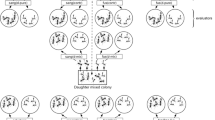Summary
In a laboratory choice-test, free-living ant workers ofFormica cunicularia andF. rufibarbis (subgenusServiformica), both potentially slave species of the obligatory slave-makerPolyergus rufescens, cared for cocoons of this parasite and for homocolonial cocoons at comparable rates. Both potential hosts did not differ in their capacity to rear the parasite brood. This fact is discussed in relation to host selection and specificity inP. rufescens. No such attraction and/or tolerance was found towards cocoons of the facultative slave-makerFormica sanguinea, which also enslaves both host species. Workers ofF. lugubris, a species which is never enslaved, destroyed cocoons from both slave-making species. The attractiveness of the brood ofP. rufescens for both potentially slave species could be due to an interspecific brood pheromone in addition to brood mimicry. An alternative hypothesis is a close phylogenetic distance between this slave-maker andServiformica species. The capacity to gain acceptance by adult slave workers might be one of the crucial evolutionary steps separating obligatory from facultative slave-making ants.
Similar content being viewed by others
References
Buschinger, A., 1986. Evolution of social parasitism in ants.TREE 1:155–160.
Buschinger, A., 1991. Host specificity and host selection in parasitic ants.Proc. 4th ECE/XIII. SIEEC, Gödöllö, pp. 682–685.
Buschinger, A. and B. Klump, 1988. Novel strategy of host-colony exploitation in a permanently parasitic ant,Doronomyrmex goesswaldi.Naturwissenschaften 75:577–578.
Buschinger, A. and U. Winter, 1983. Population studies of the dulotic ant,Epimyrma ravouxi, and the degenerate slavemaker,E. kraussei (Hymenoptera: Formicidae).Entomol. Gener. 77:74–76.
Emery, C., 1909. Über den Ursprung der dulotischen, parasitischen und myrmekophilen Ameisen.Biol. Zbl. 29:352–362.
Forel, A., 1920.Les Fourmis de la Suisse. 2nd ed. Imprimerie Coopérative, La Chaux-de-Fonds. 333pp.
Habersetzer, C., 1993. Cuticular spectra and inter-individual recognition in the slave-making antPolyergus rufescens and the slave speciesFormica rufibarbis.Physiol. Entomol. 18:167–115.
Hölldobler, B. and E. O. Wilson, 1990.The Ants. The Belknap Press of Harvard University Press, Cambridge, Mass. XII + 732 pp.
Jaisson, P., 1972. Note préliminaire sur l'ontogenèse du comportement de soin au couvain chez la jeune Fourmi rousse (Formica polyctena Först.): rôle d'un mécanisme probable d'imprégnation.C. R. Acad. Sc. Paris, 275 D:2721–2723.
Jaisson, P., 1973. L'imprégnation dans l'ontogenèse du comportement de soins aux cocons chez les Formicines.Proc. VIIth Congr. IUSSI, pp. 176–181.
Jaisson, P., 1974. Étude du développement des comportements de soins aux cocons chez la jeune Fourmi rousse (Formica polyctena Först.) élevée en milieu précoce hétérospécifique.C. R. Acad. Sc. Paris, 279 D:1205–1207.
Jaisson, P., 1975a. L'imprégnation dans l'ontogenèse des comportements de soins aux cocons chez la jeune Fourmi rousse (Formica polyctena Först.).Behaviour 52:1–37.
Jaisson, P., 1975b. Comment des fourmis apprennent à soigner leur progéniture.La Recherche 6:680–683.
Jaisson, P., 1985. Social behaviour. In:Comprehensive Insect Physiology, Biochemistry and Pharmacology, Vol. 9 (Behaviour) (G. A. Kerkut and L. I. Gilbert, Eds.), Pergamon Press, Oxford, pp. 673–694.
Jaisson, P. and D. Fresneau, 1978. The sensitivity and responsiveness of ants to their cocoons in relation to age and methods of measurement.Anim. Behav. 26:1064–1071.
Kaib, M., J. Heinze and D. Ortius, 1993. Cuticular hydrocarbon profiles in the slave-making antHarpagoxenus sublaevis and its hosts.Naturwissenschaften 80:281–285.
Le Moli, F., 1980. On the origin of slaves in dulotic ant societies.Boll. Zool. 47:207–212.
Le Moli, F. and A. Mori, 1982. Early learning and cocoon nursing behaviour in the red wood-antFormica lugubris Zett. (Hymenoptera: Formicidae).Boll. Zool. 49:93–97.
Le Moli, F. and A. Mori, 1984. The effect of early experience on the development of “aggressive” behaviour inFormica lugubris Zett. (Hymenoptera: Formicidae).Z. Tierpsychol. 65:241–249.
Le Moli, F. and A. Mori, 1985. The influence of the early experience of worker ants on enslavement.Anim. Behav. 33:1384–1387.
Le Moli, F. and A. Mori, 1987a. The problem of enslaved ant species: origin and behavior. In:From Individual to Collective Behavior in Social Insects (J. M., Pasteels and J.-L. Deneubourg, Eds.), Birkhäuser Verlag, Basel, Boston, Berlin, pp. 333–363.
Le Moli, F. and A. Mori, 1987b. Why a slave ant species accepts and cares for cocoons of its slave-maker.Ins. Soc. 34:136–141.
Le Moli, F. and M. Passetti, 1976. Osservazioni preliminari sul comportamento di scella e cura dei bozzoli inFormica rufa L. Il ruolo dell'apprendimento.Ateneo Parmense, Acta nat. 12:361–365.
Le Moli, F. and M. Passetti, 1977. The effect of early learning on recognition, acceptance and care of cocoons in the antFormica rufa L.Atti Soc. ital. Sci. nat. Museo civ. Stor. nat. Milano 118:49–64.
Le Moli, F. and M. Passetti, 1978. Olfactory learning phenomena and cocoon nursing behaviour in the antFormica rufa L.Boll. Zool. 45:389–397.
Mori, A., P. D'Ettorre and F. Le Moli, 1995. Host nest usurpation and colony foundation in the European amazon ant,Polyergus rufescens Latr. (Hymenoptera: Formicidae).Ins. Soc. 42:279–286.
Mori, A., D. A. Grasso, P. D'Ettorre and F. Le Moli, 1994. Specificity in host choice by the slave-making antPolyergus rufescens Latr. (Hymenoptera Formicidae).Ethol. Ecol. Evol, Special Issue 3:89–93.
Schumann, R. and A. Buschinger, 1991. Selective acceptance of alien host species pupae by slaves of the dulotic ant,Harpagoxenus sublaevis (Hymenoptera, Formicidae, Myrmicinae).Ethology 88:154–162.
Scortecci, G., 1972.Insetti. Vol. II. Edizioni Bolis, Bergamo, 1039 pp.
Topoff, H., 1990. Slave-making ants.Am. Sci. 78:520–528.
Topoff, H., S. Cover, L. Greenberg, L. Goodloe and P. Sherman, 1988. Colony founding by queens of the obligatory slave-making ant,Polyergus breviceps: the role of the Dufour's gland.Ethology 78:209–218.
Topoff, H., T. Weickert and E. Zimmerli, 1990. A comparative study of colony takeover between queens of facultative and obligatory slave-making ants (Hymenoptera: Formicidae).J. Insect Behav. 3:813–817.
Viehmeyer, H., 1908. Zur Koloniegründung der parasitischen Ameisen.Biol. Zbl. 28:18–32.
Wheeler, W. M., 1906. On the founding of colonies by queen ants, with special reference to the parasitic and slave-making species.Bull. Am. Mus. Nat. Hist. 22:33–105.
Wilson, E. O., 1971.The Insect Societies. The Belknap Press of Harvard University Press, Cambridge, Mass. X + 548 pp.
Zimmerli, E. and A. Mori, 1993. The role of an attractive brood pheromone in the obligatory, slavemaking ant,Polyergus breviceps (Hymenoptera: Formicidae).J. Insect Behav. 6:761–770.
Author information
Authors and Affiliations
Rights and permissions
About this article
Cite this article
Mori, A., D'Ettorre, P. & Le Moli, F. Selective acceptance of the brood of two formicine slave-making ants by host and non-host related species. Ins. Soc 43, 391–400 (1996). https://doi.org/10.1007/BF01258411
Received:
Revised:
Accepted:
Issue Date:
DOI: https://doi.org/10.1007/BF01258411




